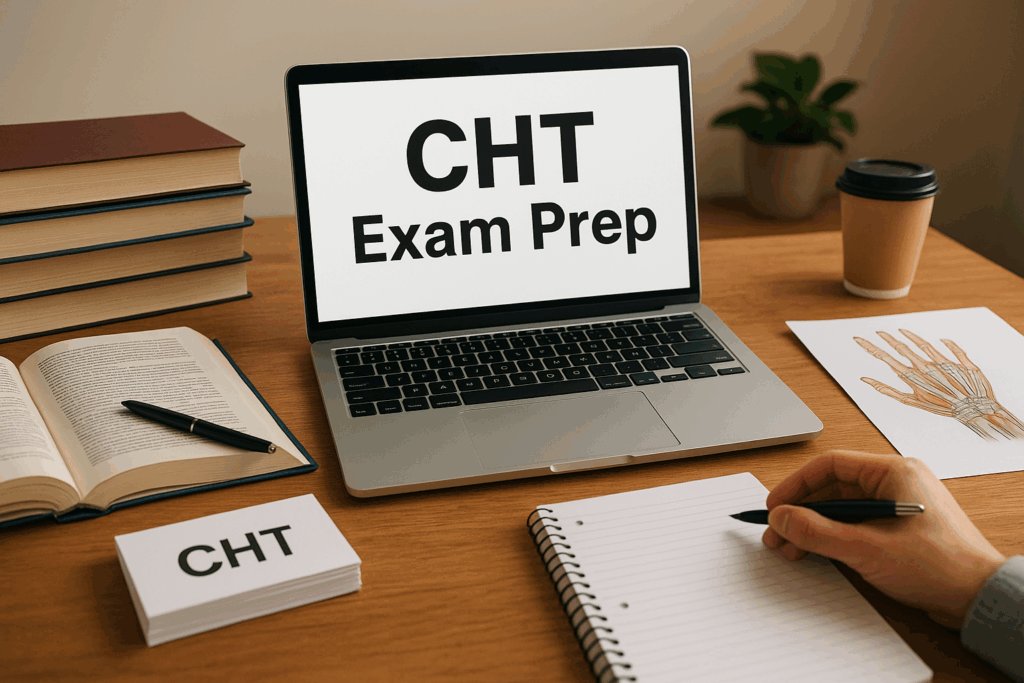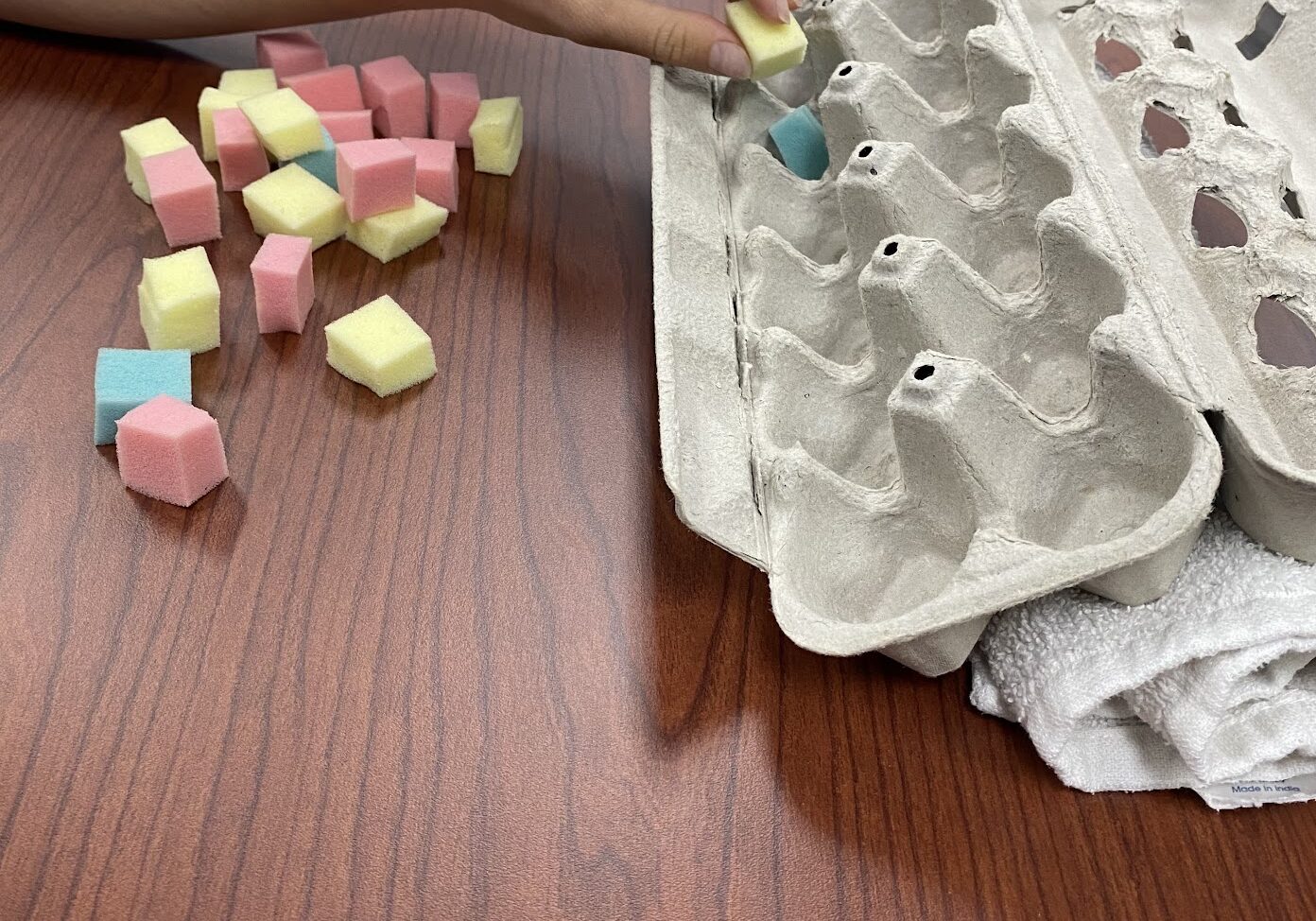Introduction to the CHT Exam
What is the CHT Certification?
The Certified Hand Therapist (CHT) credential is a prestigious and advanced professional certification for occupational and physical therapists. It demonstrates specialized knowledge in upper limb rehabilitation, including the hand, wrist, elbow, and shoulder. This certification is jointly administered by the Hand Therapy Certification Commission (HTCC) and is recognized globally in clinical hand therapy circles.
Who is Eligible to Take the CHT Exam?
To qualify for the CHT exam, a candidate must:
- 成为一名有执照的职业治疗师或物理治疗师。
- Have at least 3 years of clinical experience.
- Complete a minimum of 4,000 hours of direct hand therapy practice.
These strict prerequisites ensure that only dedicated, experienced professionals attempt this challenging exam.
Why Become a Certified Hand Therapist?
Becoming a CHT has numerous benefits:
- Professional recognition and credibility
- Higher salary potential
- Expanded job opportunities
- Enhanced clinical decision-making
- Increased patient trust and referral opportunities
This certification can be a turning point in your rehabilitation career.

Understanding the Exam Structure
形式和时长
The CHT exam consists of 200 multiple-choice questions. You’ll have 4小时 to complete the test. The exam is administered at Prometric testing centers or remotely, depending on your location and availability.
Question Types and Domains Covered
The exam covers four main content domains:
- Domains of Hand Therapy
- Diagnoses and Conditions
- Medical and Surgical Procedures.
- Treatment Techniques and tools
Expect case-based scenarios, diagram-based questions, and clinical decision-making challenges that test real-world application of knowledge.
Scoring System Explained
Scores are scaled between 200 and 800. Exact pass scores vary slightly by year and form of the test. You’ll receive your results within 6–8 weeks after the exam.
Setting a Strong Foundation
How to Set SMART Goals for Studying
SMART goals (Specific, Measurable, Achievable, Relevant, Time-bound) are key to structured studying. For example:
- “I will complete two chapters of my review manual each week.”
- “I’ll finish 100 practice questions every weekend.”
Creating a Personalized Study Plan
Break your study schedule into weekly and monthly goals based on the time you have until the exam. Include:
- Core study material coverage
- Practice test days
- Rest and review weeks
Recommended Study Timeline
| Study Timeline | 适合 |
| 12 Months | Working full-time with family or other obligations |
| 6 Months | Moderate availability, balanced workload |
| 3 Months | Intense, focused full-time prep |
Best Study Resources for CHT Exam Prep
Top Books and Manuals
- 手部和上肢康复 by Skirven
- 手部和上肢矫形干预 作者:Jacobs & Austin
- 手部治疗基础知识 作者:Coppard & Lohman
在线课程和网络研讨会
- AOTA-approved prep courses, such as CHT 准备 by Hand Therapy Academy
- Rehab professionals’ YouTube channels
- ASHT webinars and continuing ed resources
Active Learning Techniques
Case-Based Learning
Apply theory to practice by reviewing clinical case studies. Think critically: What’s the diagnosis? What interventions would you choose?
Teaching Concepts to Others
Teaching forces you to deeply understand concepts. Host mini “teach-back” sessions with peers or coworkers.
Practice Questions and Mock Exams
Take full-length practice tests under timed conditions. Use results to adjust your focus.
Managing Time and Avoiding Burnout
Weekly Study Scheduling Tips
- Block 30–60 minutes daily.
- Reserve time on the weekends for deep dives.
- Include breaks and “catch-up” days.
Avoiding Overwhelm
Recognize signs of burnout early—fatigue, frustration, declining retention. Adjust pace and integrate stress management strategies.
Rest, Nutrition, and Exercise Balance
- Get 7–8 hours of sleep.
- Eat balanced meals with brain-boosting nutrients.
- Include movement or light workouts in your routine.
Memorization Strategies for Key Concepts
Mnemonics and Acronyms
Examples:
- “Some Lovers Try Positions That They Can’t Handle” – for carpal bone order.
- “DEFORM” – stages of wound healing.
Chunking and Spaced Repetition
Break topics into digestible sections and revisit them frequently. Use flashcard toolsi for spaced repetition.
Visual Diagrams and Mind Maps
Sketch nerve paths, tendon zones, and orthotic designs. Visual learners especially benefit from this technique.
Joining a Study Group or Forum
Benefits of Peer Learning
- Accountability
- Idea sharing
- Emotional support
Top Online CHT Study Communities
- Reddit’s r/occupationaltherapy
- Facebook 群组,例如“CHT 考试学习小组”
- OT/PT Discord communities
Finding a Study Buddy
Partner with someone who’s preparing for the exam too. You can quiz each other and share insights.
Practice Test Strategy
How to Analyze Your Mistakes
After every practice test:
- Categorize mistakes by topic.
- Review and re-learn that concept.
- Retest after a few weeks.
- Use the post test categories from CHT Prep from Hand Therapy Academy’s exams
Time Management During Exams
- Spend no more than 1.5 minutes per question.
- Flag hard ones and revisit with remaining time.
Simulating Real Exam Conditions
Sit at a desk with no distractions. Use a timer. Take breaks only at designated times, mimicking actual exam behavior. Use the CHT模拟测试 simulator that contains 200 questions from real tests (three versions of the test are available) and provides detailed feedback with rationale and references for all of the answers.
Day Before the CHT Exam
需要携带的物品
Pack your bag early and make sure it includes:
- Government-issued photo ID
- Prometric confirmation email or test admission letter
- Disposable bottle of water (if allowed)
Confirm the testing location and how long it will take you to get there.
How to Calm Pre-Exam Anxiety
- Meditate for 5–10 minutes using apps like Headspace or Calm.
- Limit caffeine intake and aim for restful sleep.
- Avoid cramming; light review is better for retention.
Final Review Strategy
Focus on:
- Flashcards and quick notes
- High-yield summaries
- Topics you consistently miss on practice tests
Don’t introduce new material at the last minute—it can increase stress without improving performance.
Test Day Tips for Success
Arriving Early and Checking In
Plan to arrive at least 30–45 minutes early. Testing centers have strict protocols:
- No phones or smartwatches allowed
- Lockers are usually provided
- You may undergo a security screening
Managing Exam Stress in Real-Time
If you start to feel anxious during the test:
- Take 3 deep breaths
- Stretch your arms and neck discreetly
- Close your eyes for 30-60 seconds to avoid screen fatigue
Staying Focused and Alert
- Use the on-screen timer to pace yourself
- Take allowed breaks wisely
- Don’t dwell on difficult questions—mark and move on
考试后该做什么
Understanding Preliminary Scores
At some centers, you may receive a preliminary pass/fail notification. The official score report will arrive via email or your HTCC account within several weeks.
Steps if You Pass
- Celebrate your accomplishment!
- Update your credentials
- Inform your employer and network
- Consider mentoring others preparing for the exam
What to Do If You Don’t Pass
- Wait for a breakdown of your score
- Reflect on areas for improvement
- Take a short break before restarting prep
- You can retake the exam in 6 months
Success Stories from Real CHTs
What Worked for Them
- “I started 6 months ahead and studied 5 days a week.”
- “Practicing the real test at the HTA website was a game-changer.”
- “Daily flashcards helped me master nerve innervations.”
Study Routines Shared
- Early morning reviews
- Weekly practice exams
- Sunday summaries of weekly learning
Lessons Learned
- “Don’t neglect orthotics, even if you think you know them.”
- “Invest in quality resources—it saves time.”
- “Make rest days part of your plan.”
Top Mistakes to Avoid During CHT Exam Prep
Procrastination
Delaying your study schedule increases anxiety and decreases retention. Start early and stay consistent.
忽视薄弱环节
Focusing only on favorite topics leaves gaps. Identify your weaknesses early through practice tests.
Not Taking Enough Practice Exams
Practice exams build endurance and help simulate test conditions. Try to complete at least 3 full-length mock tests.
FAQs About CHT Exam Prep
1. How hard is the CHT exam?
The CHT exam is challenging due to the breadth of content and clinical reasoning involved. But with consistent, focused preparation, many therapists succeed on their first try.
2. What is the pass rate?
The pass rate typically hovers around 60–70%, depending on the year. Preparation is crucial.
3. How much time should I spend studying?
Most candidates study between 150–300 hours over 3 to 12 months. Your timeline depends on experience and available study time.
4. Are there prep courses that guarantee results?
No course can guarantee a pass, but reputable ones like CHT预备课程 by Hand Therapy Academy offer valuable structure and support.
5. Can I work full-time and still pass the CHT exam?
Yes! Many successful candidates balanced full-time jobs with study by creating structured plans and using weekends or early mornings.
6. How often can I retake the exam?
You can retake the CHT exam every 6 months, up to three times within a 3-year period from initial eligibility.
Conclusion: You Can Pass the CHT Exam With Confidence
Preparing for the CHT exam is a journey—one that builds not just knowledge, but clinical confidence. By creating a smart plan, using the best resources, and prioritizing your mental and physical health, you can absolutely pass the CHT exam.
Remember, every Certified Hand Therapist started right where you are now—with questions, doubts, and determination.
Stay focused. Stay consistent. And most importantly—believe in your ability to succeed.
更多阅读内容
2025年PTA和OTA继续教育终极指南
专职医疗继续教育简介 继续教育不仅仅是一项监管要求,更是专业成长、紧跟最新疗法发展以及确保最高水平的患者护理的关键一步。对于物理治疗师助理 (PTA) 和职业治疗助理 (OTA) 而言,CEU(继续教育学分)的作用不仅仅是……
阅读更多在手部治疗诊所治疗拇指疼痛竖起大拇指
“妈妈拇指”、“玩家拇指”和“桡骨茎突腱鞘炎”有什么共同点?它们都被正式称为德奎文氏腱鞘炎。德奎文氏腱鞘炎涉及第一背侧室、拇长展肌 (APL) 和拇短伸肌 (EPB) 内的肌腱,当肌腱发炎且无法穿过…
阅读更多手部治疗中的臂丛神经病案例
手部治疗中的臂丛神经病案例(神经丛病示例) 我们最近看到的一个病例是一名 13 岁的臂丛神经损伤患者。我们正在为患者进行肌腱移植术后检查,以增加其左上肢 (LUE) 的功能使用。手术前,他无法伸展手腕,并且……
阅读更多注册即可直接将更新发送到您的收件箱!
注册我们,我们将定期向您发送有关手部治疗的所有内容的博客文章、每次上传新视频和教程时的通知,以及讲义、协议和其他有用信息。





